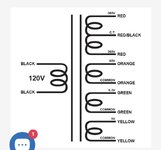VaporDemon
Member
I’m sure this is pretty common knowledge but based on the diagram, how would I wire the 60V winding to use for my bias supply? I have a bias circuit already on the board which used a 60V tap on the original PT so I’m not sure what to do with the common. I’m assuming it’s supposed to be attached to ground but I’m not 100% sure so I’m asking to make sure. I know the heater winding is attached to ground with two 100 ohm resistors as a center tap but I couldn’t find any info that is helping me understand the 60V winding for my bias supply.
The second part of my issue is my original PT had a 12 volt winding which is attached to the channel switching circuit as shown in the other diagram. I’d like to change the relays to the 5 volt version & use the 5 volt winding to power it but my question is will I need to change the value of one of the resistors for it to work or should it theoretically operate the same as long as the supply voltage is correct for the relay? I understand the basic idea of how the switching circuit works but I’m unsure of how to calculate the resistor values. I do know with both relays operating I’m measuring 200mA of current on the supply leads. I am also planning on adding another relay which I was planning to operate from one of the relays that are already there.
Thanks in advance!!!
The second part of my issue is my original PT had a 12 volt winding which is attached to the channel switching circuit as shown in the other diagram. I’d like to change the relays to the 5 volt version & use the 5 volt winding to power it but my question is will I need to change the value of one of the resistors for it to work or should it theoretically operate the same as long as the supply voltage is correct for the relay? I understand the basic idea of how the switching circuit works but I’m unsure of how to calculate the resistor values. I do know with both relays operating I’m measuring 200mA of current on the supply leads. I am also planning on adding another relay which I was planning to operate from one of the relays that are already there.
Thanks in advance!!!
Attachments
Last edited:


